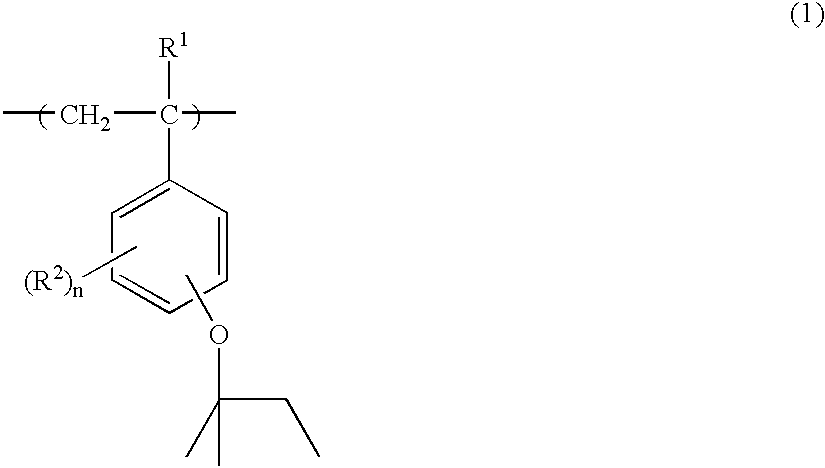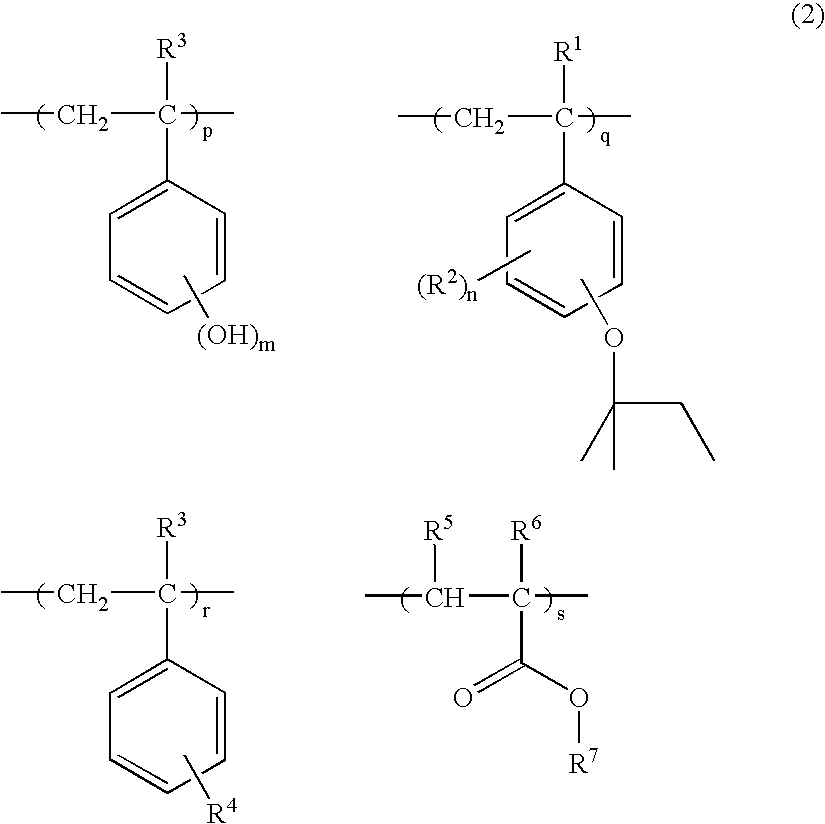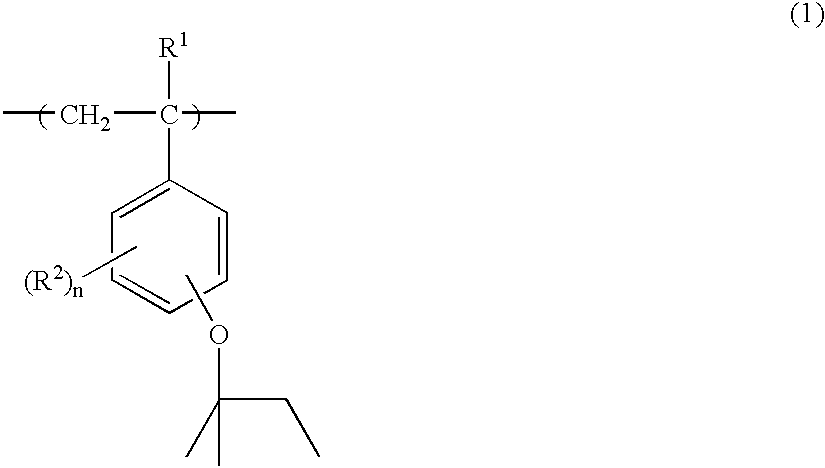Resist composition and patterning process
- Summary
- Abstract
- Description
- Claims
- Application Information
AI Technical Summary
Benefits of technology
Problems solved by technology
Method used
Image
Examples
synthesis example 1
[0079]To a 2-liter flask were added 66.5 g of p-acetoxystyrene, 33.5 g of p-tert-amyloxystyrene and 200 g of toluene as a solvent. The reactor was cooled to −70° C. in a nitrogen atmosphere, whereupon vacuum deaeration and nitrogen blow were repeated three times. The reactor was warmed up to room temperature, 3.9 g of AIBN was added as a polymerization initiator, and the reactor was further heated to 60° C., at which reaction was effected for 15 hours. The reaction solution was concentrated to a ½ volume, poured into a mixture of 4.5 liters methanol and 0.5 liter water for precipitation. The resulting white solids were filtered and vacuum dried at 60° C., obtaining 92 g of a white polymer. The polymer was dissolved in a mixture of 0.27 liter methanol and 0.27 liter tetrahydrofuran again, to which 77 g of triethylamine and 15 g of water were added to effect deblocking reaction. The reaction solution was neutralized with acetic acid, concentrated, and dissolved in 0.5 liter of acetone...
synthesis example 2
[0083]To a 2-liter flask were added 71.5 g of p-acetoxystyrene, 22.4 g of p-tert-amyloxystyrene, 8.1 g of 1-ethylcyclopentyl methacrylate and 200 g of toluene as a solvent. The reactor was cooled to −70° C. in a nitrogen atmosphere, whereupon vacuum deaeration and nitrogen blow were repeated three times. The reactor was warmed up to room temperature, 3.9 g of AIBN was added as a polymerization initiator, and the reactor was further heated to 60° C., at which reaction was effected for 15 hours. The reaction solution was concentrated to a ½ volume, poured into a mixture of 4.5 liters methanol and 0.5 liter water for precipitation. The resulting white solids were filtered and vacuum dried at 60° C., obtaining 89 g of a white polymer. The polymer was dissolved in a mixture of 0.27 liter methanol and 0.27 liter tetrahydrofuran again, to which 77 g of triethylamine and 14 g of water were added to effect deblocking reaction. The reaction solution was neutralized with acetic acid, concentra...
synthesis example 3
[0087]To a 2-liter flask were added 71.6 g of p-acetoxystyrene, 22.4 g of p-tert-amyloxystyrene, 6.1 g of 1-ethylnorbornyl methacrylate and 200 g of toluene as a solvent. The reactor was cooled to −70° C. in a nitrogen atmosphere, whereupon vacuum deaeration and nitrogen blow were repeated three times. The reactor was warmed up to room temperature, 3.9 g of AIBN was added as a polymerization initiator, and the reactor was further heated to 60° C., at which reaction was effected for 15 hours. The reaction solution was concentrated to a ½ volume, poured into a mixture of 4.5 liters methanol and 0.5 liter water for precipitation. The resulting white solids were filtered and vacuum dried at 60° C., obtaining 85 g of a white polymer. The polymer was dissolved in a mixture of 0.27 liter methanol and 0.27 liter tetrahydrofuran again, to which 77 g of triethylamine and 14 g of water were added to effect deblocking reaction. The reaction solution was neutralized with acetic acid, concentrate...
PUM
| Property | Measurement | Unit |
|---|---|---|
| Temperature | aaaaa | aaaaa |
| Bond length | aaaaa | aaaaa |
| Bond length | aaaaa | aaaaa |
Abstract
Description
Claims
Application Information
 Login to View More
Login to View More - R&D Engineer
- R&D Manager
- IP Professional
- Industry Leading Data Capabilities
- Powerful AI technology
- Patent DNA Extraction
Browse by: Latest US Patents, China's latest patents, Technical Efficacy Thesaurus, Application Domain, Technology Topic, Popular Technical Reports.
© 2024 PatSnap. All rights reserved.Legal|Privacy policy|Modern Slavery Act Transparency Statement|Sitemap|About US| Contact US: help@patsnap.com










